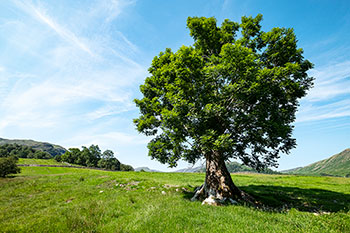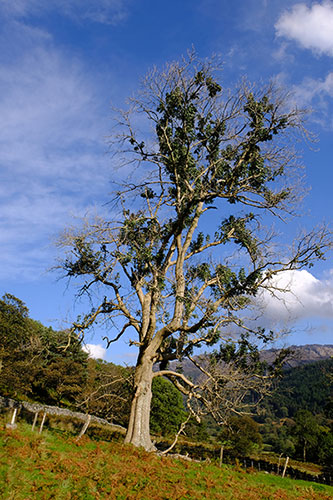
Ash trees are one of the most prominent trees in our gardens, fields and hedges.
If you own an ash tree, we need your help to make sure your trees don't become a danger to people or property.
Ash trees can decline rapidly once infected and become brittle and weak at the roots, especially if a secondary pathogen attacks the tree.
If you aren't sure if your trees are Ash, the Woodland Trust has a good guide - Ash (Fraxinus excelsior) - British Trees - Woodland Trust
Identifying signs of ash dieback - The Tree Council identification guide in larger trees
The Forestry Commission also has a number of videos on how to identify symptoms:
Diseased Ash Tree:

If you have an ash tree on your property or land, you should be aware of your responsibility to ensure it does not become a risk to other people or property. Ash trees can decline rapidly once infected and become brittle and weak at the roots, especially if a secondary pathogen attacks the tree.
If it is within falling distance of the public highway (including footpaths and bridleways) and shows signs of ash dieback, you may be served with a notice to carry out works (which may include felling the tree) from Cumbria County Council.
All trees should be regularly inspected for safety by a suitably qualified arboriculturist but if you own ash trees it will be useful to learn how to recognise the symptoms of the disease so that you are well prepared to deal with this disease as early as possible.
Ash Dieback Disease: A guide for tree owners
Carrying out works
Please don't fell ash trees if they are not yet dangerous and certainly not if they are not infected - this will not prevent the spread of the disease. Some ash trees are resistant to the disease and others are able to tolerate an infection and return to reasonable health. These trees will be valuable for the continuation of the species.
If removal of a dangerous tree is required, you will need to get a professional to carry out the work. Tree felling is dangerous work, but when felling badly infected ash, the hazards can greatly increase. It is extremely important that you use someone who is properly qualified and insured, as special precautions and techniques may be required to ensure safety.
Licences and permits may be required
For trees outside gardens or for those subject to Tree Preservation Orders or in Conservation Areas, please ensure that you have secured all permissions and licences before you fell trees or you may be committing an offence and liable to prosecution. Please note that Tree Preservation Orders and Conservation Areas are managed by your district council and are not a matter for the county council.
You need to ensure that appropriate health and safety measures are in place for before work begins. This should include any road traffic management measures that may be necessary.
Please take the proper measures to ensure that wildlife legislation is not contravened by the works. For example, bat roosts and nesting birds are both commonly found in older trees and disturbing them is an offence. Thick ivy growth can conceal nests and roosts.
We are currently surveying the county's roads in order to record where ash trees are and what level of infection they are showing. This information will help prioritise any action required, such as felling or further inspections.
We will work closely with districts, boroughs and parish councils, as well as members of the public who own ash trees close to public highways.
If landowners have received a letter regarding felling Ash trees and need more assistance, please report it online or contact Cumbria Highways on 0300 373 3306.
16 January 2023 - Ash Dieback branches out through Cumbria
1. What can be done to help combat the spread of ash dieback amongst trees? Especially if there is no cure
Unfortunately there is little that can be done to stop the spread, as it is now county wide. The fungal spores are spread on the wind
But it is recommended to
- Clean your shoes before and after visiting a wood.
- Avoid taking cuttings or plant material from the countryside.
- Wash your car or bike wheels to remove mud or plant matter.
To help prevent the spread of the dieses or any other disease.
2. Do you think this could be worse than the Dutch Elm outbreak in the 70's?
Yes, Ash is a predominant tree species in the Cumbria landscape and it is estimated that we are going to lose around 80% of Ash trees in Cumbria and the UK
3. What could this do to change the landscape in Cumbria?
This is going to have a devastating impact on the landscape and the biodiversity of our woodlands, as well as a major loss in connections between habitats as we lose hedges and individual trees outside of woods.
4. Is there any danger to public health?
The disease is not known to affect human health, however it effects the structure and stability of the tree in the long term, which could lead to branch/ tree failure.
5. How can you spot an infected tree?
Please go to the Woodland Trust website
Ash Dieback (Hymenoscyphus fraxineus) - Woodland Trust
The best time to see Ash Dieback fully is during the summer months when the tree is in leaf.
6. What advice would you give to people if they suspect they come across an infected tree?
Depending on location, report this to the land owner if possible, so that they can take action.
7. How can members of the public help?
During the summer keep an eye on trees and report any issues to the landowner so they can be dealt with.
8. What dangers could this bring to the road network?
The disease affects the structure of the tree making them frail and also unable to defenced from secondary infections, which can also lead to the tree becoming unstable.
This means that they can fail on to the highways network at any point and endangering the public.